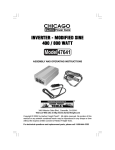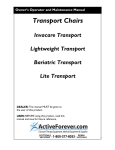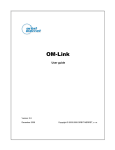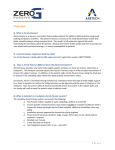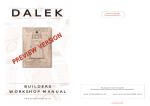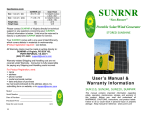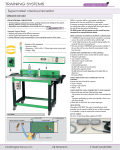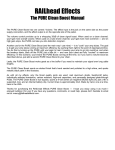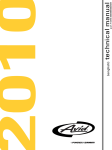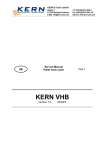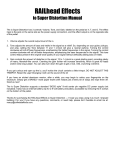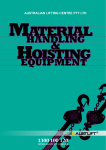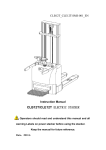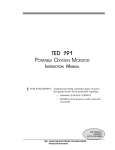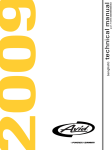Download trakrat® Link
Transcript
www.trakrat.com LT 1000 P LT 1500A LT 1250A ® trakrat Link-Trolley Instruction Manual Thank you for purchasing a trakrat® Link-Trolley Before using this equipment and to avoid personal injury, carefully read and understand these instructions. If there is anything you do not understand, DO NOT use this equipment, contact your supplier for advice. Regular inspection, servicing and periodic maintenance will ensure many years of trouble free operation. CONTENTS trakrat® Link-Trolley SECTION 1 SECTION 2 SECTION 3 SECTION 4 SECTION 5 SECTION 6 SECTION 7 SECTION 8 SECTION 9 PAGE Introduction / Disclaimers General Safety / Risk Assessment Know your trakrat® Link-Trolley Assembly Instructions Operating instructions Cleaning and general care Technical data Warranty Stopping Distance Table 1 2–3 4 5 6 8 11 11 12 Bogie Brake Inspection Test SECTION 10 SECTION 11 SECTION 12 SECTION 13 SECTION 14 SECTION 15 General Inspection Test Procedure Brake Pad / Wheel / Disc Replacement Procedure Disc and Wheel Removal Brake Pad Removal SECTION 16 SECTION 17 Label Information Certification 9 10 25 - 31 trakrat® Link-Trolley INTRODUCTION DESCRIPTION The trakrat® Link-Trolley is a portable link trolley for use on rail infrastructure. Polymer Link Trolley,TR 1000 P : Constructed from Polypropylene and aluminium to give a combination of strength with minimum weight. NB: Please note that local practice may limit the SWL capacity to 1000Kg Model Number Description Capacity (kgs) Deck (mm) LT 1000 P Link Trolley 1000 Plastic 1000 800 x 1750 LT 1250 A Link Trolley 1250 Aluminium 1250 750 x 1800 LT 1250 A - I Link Trolley 1250 Aluminium - Insulated 1250 750 x 1800 LT 1250 W Link Trolley 1250 Wood 1250 750 x 1800 LT 1250 W - I Link Trolley 1250 Wood - Insulated 1250 750 x 1800 LT 1500 A Link Trolley 1500 Aluminium 1500 1150 x 1800 LT 1500 A - I Link Trolley 1500 Aluminium - Insulated 1500 1150 x 1800 LT 1500 W Link Trolley 1500 Wood 1500 1150 x 1800 LT 1500 W - I Link Trolley 1500 Wood - Insulated 1500 1150 x 1800 1 The trakrat® Link-Trolley comprises of a deck and two bogies. Both bog i es are detachable to enable the users to transport the trakrat® Link-Trolley manually over reasonable distances where access by vehicular transport is not an option The trakrat® Link-Trolley is fitted with a unique disc brake system which increases braking efficiency and reduces wheel damage associated with traditional block brakes. An additional version is available with wheels isolated from the main bogie for use on underground rail systems. DISCLAIMERS Due care has been taken in the publication of this User /Operator Manual, but it is intended as a guide only. The information and instructions included in this manual are provided to help you get the best possible service from your trakrat® Link-Trolley. Users are reminded of their individual responsibility to ensure health and safety at work and their duty under current Health and Safety Legislation. No warranties are implied or offered in relation to this manual, its content or use and Wolfe Designs Ltd. accept no liability whether actual or consequential arising from its use, or that its use alone is sufficient to ensure the safety of those so engaged. Your statutory rights remain unaffected. Wolfe Designs Ltd operate a policy of constant improvement and reserve the right to change specifications without notice. Wolfe Designs Ltd. reserve the right to alter/delete or make additions to this manual without notice at any time as is deemed necessary. SECTION 2 SAFETY To ensure that the trakrat® Link-Trolley is used safely and responsibly, we strongly recommend that this manual is read by all users prior to operating the trakrat® Link-Trolley, and that the recommendations are followed at all times. Make sure you are aware of all safety requirements and that this equipment is suitable for the task you wish to undertake. This equipment must not be moved, set up, used or dismantled by persons who are under the influence of alcohol or drugs. Do not use this equipment if you are tired or unwell. Test brakes in accordance with brake test procedure as published. Always read and follow the safety information found on the details fitted to the trakrat® Link-Trolley. Be aware of trap hazard between 2 linked trolleys. Use red indicator lights where required. Do not overload the platform beyond the stated weight loading for the model you have and ensure that you secure any load adequately. Wear the correct Personal Protective Equipment for the task you are performing. Do not wear loose jewellery or clothing that may get in the way or become trapped in the mechanism. Inform everyone in the work area of what you are doing. Carefully inspect the trakrat® Link-Trolley during and after assembly and before each work session, if there is any doubt about its condition, DO NOT USE IT. A competent person should remain close by whenever the equipment is being used, in case of an emergency. It is the responsibility of all user’s to carry out a full risk assessment and ensure that a safe working environment is created and secured with safe working practices before using the trakrat® Link-Trolley. EMERGENCY OFF-TRACKING To off-track in an emergency requires two people. Each person should grasp the lifting handle from one side of the unit and raise so that the bogie on the other side is used to pivot the trakrat® on the track. Your risk assessments must include, but are not limited to: • Manual Handling • Safe Working Conditions • Safe Operation • Safe and Secure Transportation The trakrat® Link-Trolleys must only be used by authorised personnel, suitably trained in their use and deployment. Where needed it is the operator’s responsibility to ensure all necessary Permits/permissions or authorisations are in place prior to using this equipment on the infrastructure. 2 trakrat® LINK TROLLEY RISK ASSESMENT Issue 1 Dated: 2007 PURPOSE This document is intended to provide an assessment of the hazards and risks involved to the user(s) of the trakrat® Link Trolley. This document does not replace trakrat® Link Trolley user manual which is required reading for any user(s) whom will additionally require training to perform the safe deployment and use of this machine in accordance with BSEN13977:2005(E). TASK Deployment / Use of the trakrat® Link Trolley GENERAL SAFETY Operatives must be fully trained in all aspects of the trakrat® Link Trolley including: Assembly/lifting/use/maintenance/personal protection equipment. Prior to use: Consult the manual Confirm brake test labels are within date (each bogie has an independant brake test label) Ensure correct assembly Note that bogie/trolleys labelled for use on LUL (London Underground) must NOT be used on Network Rail. Bogie/trolleys labelled Network Rail must NOT be used on LUL London Underground) HAZARD RISK SOLUTION Incorrect assembly Personal injury Check correct assembly Lifting assembled trolley Personal injury LT1500A. Where possible remove bogies and lift components seperately. Maneuvering Personal injury to self or others Ensure safe and proper access Dropping Personal injury to self or others Overloading / Uneven Loading Personal injury and damage to the trolley Overhanging loads Injury to self and others plus damage to Exercise caution and never allow overhanging loads to under hang the the infrastructure deck Brake failure / Runaway Injury to self and others plus damage to Check and maintain the brakes infrastructure Never tie off failsafe braking devices Tripping Personal injury Walk at a proper pace for the prevailing conditions Transport / Storage Personal injury to self or others Ensure all components are properly stacked and secured Minimum 3 man lift or 4 man lift for the 3 Ensure conditions underfoot are viable and min 3 man lifts , 4 man lift for LT1500A Observe load limits SECTION 3 KNOW YOUR trakrat® LINK-TROLLEY 1a. Deck Polymer 1a 6 1b. Deck Aluminium 750mm 4 5 16 1c. Deck Alluminium 1150mm 16 2a. Bogie (750mm) 15 2b. Bogie (1150mm) 3. Locking Hand Wheel 8 LT 1000 P 4. Push Handle 8 2a 5. Brake Handle 16 9 4 6. Brake Pivot Plate 7. 1b Trolley Coupling Cap 6 8. Lifting Handle 9. Wheel 8 10. Axle 11. Spacer (Large) 5 12. 19MM Nylon Washers x 2 (On inside of box section) 2a 16 13. M12 Nylok Nut 9 14. Standard Disc 15. Bogie Body 16. Warning Light Holder 17. Bogie Anti Skew Receptacles 18 . M12 Washer 1b 4 6 8 16 2b 5 9 LT 1500 A 4 LT 1250 A SECTION 4 ASSEMBLING THE trakrat® LINK-TROLLEY Position the deck upside down on a firm level surface. Bogie Bogie Deck LT 1250 A LT 1000 P LT 1500 A Check that the ‘brake test date’ label is valid on each bogie. Position either aluminium bogie onto the deck, with the brake push rod facing inward. Retain the bogie in place by turning the locking hand wheel clockwise until secure. Ensuring that the anti skew pins on the deck match up to the receptacles on the bogie, and the bogie sits flush with the deck. Check that all brakes function.The braked wheel must resist attempts to rotate it with one hand. Repeat for other side. Roll the deck over until it is standing on its wheels. Lift the unit onto the track with all wheels correctly positioned ready to use. Lifting will require a minimum of 33 persons, Insert the push handle into receiving sockets, ensuring it is fully and securely engaged. or 4 persons for the LT1500A. Brake Handle Bogie Brake Push Rod Two pins and two recepticles per side Brake Pilot Plate Trolley Coupling Plate Insert the brake pivot handle onto the brake pivot plate and carry out a test to confirm that moving the handle in the direction of the ARROW label releases both the wheel brakes evenly. Push Handle Receiving Slot Dir ect io no f Tr ave l Brake Pivot Plate Note: both push handle and brake pivot handle can be fitted to either end of the deck and should be placed so that the operator is pushing the unit in the required direction, NOT pulling. 5 WELDERS TROLLEY The Welders Trolley comprises of LT 1500 A, with the option of a frame that supports a pair of gas cylinders. Insert one frame into receiving sockets on one side of the deck and the remaining frame on the opposite side. ensure both are fully and securely engaged. Next, connect the two bottle braces to their respective anchor points. * Gas bottles must be stood vertically against the bottle brace bars, and be strapped / roped securely via the tie down eyes provided. LINKING TRAKRAT® LINK-TROLLEYS You may link a maximum of 2 trakrat® Link-Trolleys but you may not link to any other make or model. Place 2 trakrat® Link-Trolleys in tandem on the track, ensuring that the brake release direction arrows point in the same direction on each unit. Gently bring them together until the ‘brake pivot plates’ make contact. Slide the ‘pivot connecting cap’ over the two ‘brake pivot plates’ and double check that they are locked together. Note that you can link an LT 1250 A with an LT 1500 A. Activate the brake pivot handle and ensure that all brakes are releasing properly. SECTION 5 OPERATING THE TRAKRAT® LINK-TROLLEY The trakrat® Link-Trolley is fitted with two disc brakes, one either side, which remain engaged under normal operation.When moving the trakrat® Link-Trolley, the brake mechanism must be manually released. To release the brakes, move the brake lever in the direction of the ARROW (Label) and hold in position. As soon as you release the lever, the brakes will re-engage. Should the brakes fail to re-engage, the trakrat® Link-Trolley must be removed from service immediately. Note the brake lever only moves in the direction of the arrow. Align direction arrows when linking trolleys IN USE CAUTIONS AND LIMITATIONS Be aware at all times of conditions underfoot; never walk on the railhead or sleepers. Conditions underfoot will change immediately if wet or icy. Up to 1 in 250 3 2 1 Gradients, load, ice and wet conditions will all affect the braking distances 1 in 250 to 1 in 150 3 2 1 and braking effort required. Always work with sufficient personnel to perform the task at hand, 1 in 150 to 1 in 70 (4) 3 1 working within the guidelines for manual handling and operation of this 1 in 70 to 1 in 50 (5) (4) 2 equipment. 1 in 50 to 1 in 30* (5) (4) 2 You must observe 2000kg maximum load pushable by three operatives. Number of persons required to push a loaded trolley as indicated in CoP0018 Code of Practice. LOAD GRADIANT 1500kg 1000kg 500kg * Where authorised by local instructions ( ) Theoretical figures, not recommended. It is recommended that no more than 3 men push a trolley. DO NOT • • • • • • • • • • • • Tie off, mechanically or otherwise the braking handle. Use the trolley if the brake test labels are either missing or out of date. Link trakrat® Link-Trolley with other manufacturer’s link trolleys;THEY ARE NOT COMPATIBLE. Tow, ride on, motorise or exceed walking pace with trolleys. Stand on trolley. Overload. Example: where the maximum load = 1000 kg per trolley. (eg. 2000 kg over 2 trolleys = 1000 kg each NOT 1500 kg on no.1 and 500 kg on no. 2). Place hot items above 65°C (crucibles, welding torches etc.) onto Polypropylene deck. PERMANENT DAMAGE WILL OCCUR. Allow the load to under hang the deck, it may impact the brake mechanism or the infrastructure. Drag items over the edge of the deck.You must only lift all items and place on to the deck. Use the Trolley near live DC third rail or fourth rail. Use the Trolley with insulated wheels where live overhead AC power lines are present. Link more than 2 trolleys together. 6 SECTION 6 CLEANING AND GENERAL CARE Observe local regulations. Operate within Manual Handling Regulations. Adherence to guidelines. All maintenance/inspection procedures must be carried out within the guidelines set out in Rail Industry Standards for Portable and Transportable Plant Used for Infrastructure Work as well as those criteria mandated by CoP0018, Code of Practice for Rail mounted Manually propelled Equipment. Axles, wheels and brakes are defined under CoP0018 as Railway Safety Critical and must be maintained in accordance with the guidelines laid out in CoP0018, Maintenance Elements of Small Plant and Equipment. GENERAL GUIDELINES Always adhere to the maintenance schedule as detailed below. Use only original trakrat® Link-Trolley replacement components. Only trained, competent staff should complete all work. Re-cycle used components where possible. DAILY… Inspect all components for damage or abnormal wear. Check integrity of deck/sub frame fastenings. Check integrity of all bogie fastenings Check security of axle retaining pins. Check Maintenance Brake Test Label is in date for each bogie. Test the operation of all brakes by turning each braked wheel with one hand, the wheel must resist attempts to rotate it. WEEKLY… Carry out the daily inspections as above plus: Inspect all wheels for wear/damage. Operate and inspect brake linkage tubes. Check legibility of all labels. QUARTERLY… BRAKES Perform a complete maintenance brake test: Refer to brake test/inspection and replacement section of the workshop manual. Inspect all linkages, ensure they are free from damage and operate easily. Remove all brake pads, inspect for wear and contamination, clean and replace as required. Pads must be replaced if the brake material gap is less than 1mm thick. Clean and lightly grease all moving components including all springs whilst reassembling the brake callipers. Re-fasten all fastenings and test to the appropriate torque settings. Re-adjust brake levers to remove any play from the system. Re test using torque brake test, complete the "Maintenance Brake Test Record Sheet" Conduct practical brake test. Minimum acceptable torque figure of 90Nm (65lbs ft) must be achieved. If the brakes do not achieve the minimum figure, replace or adjust components as required. BEARINGS/AXLES Examine all wheel bearings for play/noise and replace if worn. Check the end float on each axle does not exceed 3mm, re-shim with new spacer sets if required. WHEELS Conduct a detailed examination of the Aluminium wheels. Check for signs of excessive wear or distortion and compare dimensions against the P1 profile guage, refer also to diagram on page 16. If the wheel is worn to the limits indicated on the guage or is likely to reach the max wear limit before the next scheduled inspection the wheel must be replaced. UV DEGRADATION All plastics are susceptible to UV degradation. Check all polymer components for stress fractures, hairline cracks and brittleness. 7 C CODE NO. 8 SECTION 7 TECHNICAL DATA LT 1000P LT1250A LT1500A Overall Weight 80 Kilos 76 Kilos 97 Kilos Deck 40Kg 36Kg 49Kg 20Kg 20Kg 24Kg Bogie Each Centre Of Mass Central Central Central SWL 1000Kg 1250Kg 1500Kg Length 800mm 750mm 1150mm Width 1750mm 1800mm 1800mm Platform Height From Rail Crown 370mm 330mm 330mm Overall Height Including Push Rail 1000mm 1000mm 1000mm Platform Area 1400mm3 1215mm3 1860mm3 Maximum Gradient 1:30 1:30 1:30 The SWL is based upon a load evenly distributed over the deck and may be revoked by local codes of practice. COMPLIANCE trakrat® Link-Trolley complies with: GM/RT 1310 BSEN 13977:2005(E) European Machinery Directive (CE) SECTION 8 WARRANTY Your trakrat® Link-Trolley is covered by a 12 month warranty.The Company undertakes to replace or repair, free of charge, any defect which the Company considers to be due to faulty workmanship or material within 12 months of the sale date, except for: • Defects arising from neglect, misuse or unauthorised modifications. • Damage caused by abuse, misuse, dropping or other similar damage caused by or as a result of failure to follow transportation, storage, loading or operation, instructions. • Alterations, additions or repairs carried out by persons other than the Manufacturer or their recognised distributors. • Transportation or shipment costs to and from the Manufacturer or their recognised agents, for repair or assessment against a warranty claim, on any trakrat® Link-Trolley or component. • Materials and/or labour costs to renew, repair or replace components due to fair wear and tear. • Faults arising from the use of non-standard or additional parts, or any consequential damage or wear caused by the fitting or use of such parts. IMPORTANT – warranty may at the sole discretion of the manufacturer be voided if the scheduled maintenance/inspections are not carried out by a competent person. The Manufacturer and/or their recognised agents, directors, employees or insurers will not be held liable for consequential or other damages, losses or expenses in connection with or by reason of or the inability to use the trakrat® Link-Trolley for any purpose. MODIFICATIONS: If additional equipment or any third party work, modifications or alterations are to be carried out on the trakrat® Link-Trolley, which will involve any welding, drilling or any form of cutting or distortion of materials, full written approval must be obtained from the Manufacturer prior to the work being carried out. SECTION 9 STOPPING DISTANCE TABLE Figures quoted are the maximum permitted under BS EN 13977:2005 (section 5.4) Stopping Distance at Stopping Distance at Gradient 3mph (5km/h) – Wet Rail 3mph (5km/h) – Dry Rail Level – Single Trolley 6m 10m 1 in 27 – Single Trolley 10m 14m 9 www.trakrat.com Bogie Brake Inspection Test Bogie Brake Inspection Test SECTION 10 GENERAL Full inspections of the bogie braking system must be carried out at 3 monthly intervals in line with codes of practice documented in COP 0018 March 2006. The results of these inspections reported in the maintenance log and new validation labels indicating the next 3 monthly inspection date applied to each wheel set at the position indicated. IMPORTANT: As each wheel set (Bogie) is completely independent, and interchangeable from deck to deck. Each wheel set (Bogie ) will require its own report form and ‘Brake Test Label’ TOOLS REQUIRED 19mm ring spanner x 2 10mm ring spanner 4mm allen key 5mm allen key trakrat® brake test tool / torque wrenches. Vernier or rule SECTION 11 INSPECTION With the wheel set upside down on a suitable surface, visually inspect the brake pads.They require a minimum gap. of 1.00mm to be operational. If it is likely that this figure will be reached before the next quarterly inspection, replace the pads now! Minimum 3.5mm Pad Minimum 1.0mm Check the condition of the brake disc. It should be free of ruts and have a minimum thickness of 3.5mm. Replace as necessary. Inspect and check the wheel/bearings for wear or damage. Replace as necessary. SECTION 12 TEST PROCEDURE Testing should be done with dry wheels / brake pads ‘trakrat®’ BRAKE TEST TOOL Insert the “brake test tool” into the receiving holes in the disc. Locating the tool over the axle to stabilise it whilst the torque wrench is attached. Set the torque wrench to 65lbs ft / 90Nm, and apply.The wheel should not rotate. This test is applied to each quarter turn of the wheel. Test as above - Release brake, rotate wheel one quarter turn and repeat torque test. 11 Test Receiving Holes Disc Brake Test Tool Torque Wrench If the minimum torque figures are not obtained, tighten the adjusting nut on the Brake Pad Tensioning Spring and re-test as above. To adjust, release the lock nut, turn the adjuster nut clockwise as viewed then retighten the lock nut. 19mm Spanner 19mm Spanner INCREASE TENSION TIGHTEN DECREASE TENSION LOOSEN Adjuster Nut Lock Nut Once successfully completed: Fill out the form entitled “Maintenance Brake Test Reccord", and apply the ‘New Test Date Label’ SECTION 13 BRAKE PAD / WHEEL / DISC REPLACEMENT PROCEDURE (1) Release external 19mm locknut on the tension adjuster bolt. 19mm Spanner TIGHTEN LOOSEN Lock Nut (2) Turn the 19mm adjuster nut anticlockwise as viewed until tension spring is fully released. 19mm Spanner INCREASE TENSION Spring Tension Released DECREASE TENSION Adjuster Nut 12 (3) Remove 19mm axle retaining nut. 19mm Spanner Axle Retaining Nut Axle SECTION 14 DISC AND WHEEL REMOVAL (4) Remove the four 4mm allen headed shoulder bolts one at a time, depressing the actuator and rotating the wheel to gain access as you progress. If fitted with insulating washers, these should be discarded and new ones fitted during the rebuild. Insulating Washers Allen Bolt Allen Socket (5) Partially remove axle, using a suitable drift. Axle Drift 13 (6) Press the actuator and slide disc aside then remove the large spacer tube. Press the actuator again and remove disc. Finally, completely remove axle and remove the wheel, and two nylon spacers. Wheel Two Nylon Spacers Disc Large Spacer Insulating Bearing Housing (7) Brake pads are now fully accessible. Outer Pad Inner Pad Mounting Posts Spring SECTION 15 BRAKE PAD REMOVAL (8) Loosen both brake pad retaining hex bolts. Note: the brake pad retaining bolts are the outer of the four, DO NOT loosen the inner two. Carefully remove both pads / springs. Brake Pad Retaining Bolts Brakepad Retaining Bolts Mounting Posts ! DO NOT LOOSEN ! (9) Carefully remove both pads and springs. Clean / grease the mounting posts and springs. To fit new brake pads simply reverse the above procedure. 14 Inner Pad Springs Outer Pad trakrat® Maintenance Brake Test Record 15 P1 PROFILE RAIL WHEEL 16 Labelling We are able to label bogies, and or trolley decks with a variety of labels. In general however we are indicating what are accepted within the UK Rail networks, Whether that be overground which genrerally comes under the duresdiction of Network Rail or underground which generally applies to London underground or LUL. When ordering outside the UK please specify the labelling you require if they differ from those shown on these pages. ** UK OR ** UK NOTE: BOGIE SERIAL NUMBERS ARE NOW ALSO ETCHED ONTO THE BOGIE 17 The labelling shown depicts that which we supply to the UK rail industry. If your requirements differ, then please state clearly at the time of order. 18 For detail on bogie label set and location see LT1250A bogie 19 Labelling shown depicts that which we supply to the UK Rail industry. In the case of decks whether that be the LT1250 or LT1500 we would include all the following, plus if you wish to add SWL labelling to the deck rather than the bogies please ensure we are made aware. 20 21 22 23 Note that labels TRA-121, TRA-140, TRA-141 relate to UK Network Rail or London Underground (LUL). In all cases "Insulated" refers to the bogie having insulated wheels. Serial Numbers are etched onto bogies and decks subject to customer requirements 24 25 26 27 28 29 30 31 32 Please be advised that the contents of this document remain the property of the company and are only released on the basis of assisting clients of the company maintain their fleets. The contents must not be used for any other purpose whatsoever it must not be copied nor transmitted to any other than the company to whom it was supplied. It must not be held on any other internet web site than trakrat.com it is not to be considered to be in the public domain.


































